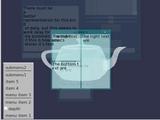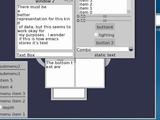Posts Tagged region-based
Region-based tracking
I recently had to revisit some tracking from last year. In the process, I uncovered some other relevant works that were doing region-based tracking by essentially segmenting the image at the same time as registering a 3D object. The formulation is similar to Chan-Vese for image segmentation, however, instead of parameterizing the curve or region directly wiht a level-set, the segmentation is parameterized by the 3D pose parameters of a known 3D object. The pose parameters are then found by a gradient descent.
Surprisingly, the formulation is pretty simple. There are two similar derivations:
1) PWP3D: Real-time segmentation and racking of 3D objects, Prisacariu & Reid
2) S. Dambreville, R. Sandhu, A.Yezzi, and A. Tannenbaum. Robust 3D Pose Estimation and Efficient 2D Region-Based Segmentation from a 3D Shape Prior. In Proc. European Conf. on Computer Vision (ECCV), volume 5303, pages 169-182, 2008.
3) There is another one from 2007. Schamltz.
This is similar to aligning a shape to a known silhouette, but in this case the silhouette is estimated at the same time.
The versions are really similar, and I think the gradient in the two versions can be brought into agreement if you use the projected normal as an approximation to the gradient of the signed distance function (you then have to use the fact that = 0). This should actually benefit implementation 1) because you don’t need to compute the signed distance of the projected mesh.
I implemented the version (2), in what took maybe 1 hour late at night, and then a couple more hours of fiddling and testing it the next day. Version 1) claims real-time; my implementation isn’t real-time, but is probably on the order of a frame or 2 a second. The gradient descent seems quite dependent on the step size parameter, which IMO needs to change based on the scene context (size ot object, contrast between foreground and background).
Here are some of the results. In most of the examples, I used a 3D model of a duck. The beginning of the video illustrates that the method can track with a poor starting point. In fact, the geometry is also inaccurate (it comes from shape-from-silhouette, and has some artifacts on the bottom). In spite of this, the tracking is still pretty solid, although it seems more sensitive to rotation (not sure if this is just due to the parameterization).
Here are 4 videos illustrating the tracking (mostly on the same object). The last one is of a skinned geometry (probably could have gotten a better example, but it was late, and this was just for illustration anyhow).
http://www.youtube.com/watch?v=ffxXYGXEPOQ
http://www.youtube.com/watch?v=ygn5aY8L-wQ
http://www.youtube.com/watch?v=__3-QB_7jhM
http://www.youtube.com/watch?v=4lgemcZR87E






